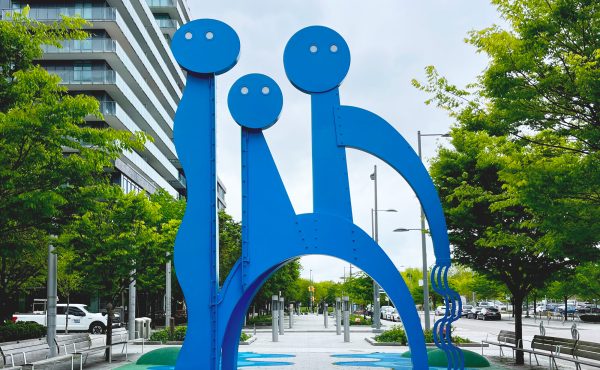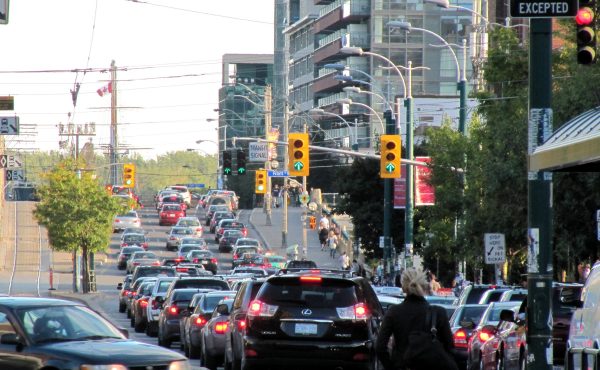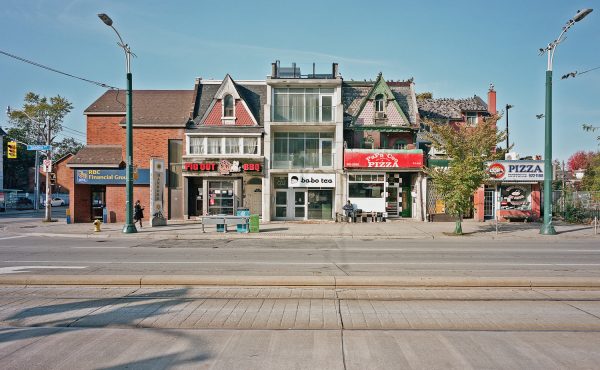Back in May, Spacing publisher Matt Blackett and myself drove up to Montreal for a few days to work on a Spacing project (details to come). While we were there, we looked at some of the city’s street furniture and interesting public space initiatives.


One of the most interesting programs for me was the advanced pedestrian signals. At a lot of intersections in Montreal now, when the traffic light turns green, it starts for a few seconds with just a forward arrow along with the walking man (meaning cars can drive forwards but not turn). Since cars can’t turn right on reds in Quebec, what this means is that pedestrians have time to start crossing the street without worrying about a car trying to make a quick right or left turn ahead of them and almost running over their feet — something that I often experience in Toronto. Depending on the one-way configuration of the streets, you can also simply get a pedestrian signal for a few seconds while the traffic light stays red.

We also noticed a lack of bike racks, and bikes locked to all kinds of things (including, sadly, trees). We found this surprising until Montrealers explained to us that all of the bike racks on sidewalks, along with some other street furniture, are removed every winter to allow for snowplowing the sidewalks. The city had not yet finished re-installing this furniture for the summer at the time we were there.

In light of the new street furniture program in Toronto, which will include new “information pillars” that will carry ads on two sides and maps on one side, it was interesting to see the long-established ones in Montreal. While I don’t like info pillars on principle, at least those in Montreal have location-specific maps — they are customized according to the placement of a particular pillar (e.g. if you are looking eastwards when you look at a particular map, that map is oriented towards the east, and your location is always centred). We can at least hope that an equal degree of customization will be used for the Toronto ones (unlike the ones that were put up in our parks a couple of years ago, which mostly use generic maps).

Finally, on Bernard Avenue, which has recently been upgraded to create a better pedestrian environment, we really admired the metal grating covers on the tree pits — not only were they extremely functional, allowing rainwater in while keeping people from stepping on the roots, but they were also attractively designed. One thing we really need to get in Toronto is a standard that specifies that tree pit covers should be metal grating rather than concrete, to allow rainwater in.




12 comments
Notice how positive the signs in Quebec are? In Ontario, we have signs which show the directions you cannot turn. In Quebec, they tell you which ways you CAN. Uplifting!
I was in Montreal at the start of June, and I still noticed the lack of bike racks even then. They did, however, have some nice on-street bike parking initiatives like infront of the Velo Quebec office (Pic). (Their ridiculous bike lanes, however, left much to be desired)
Another interesting thing about their pedestrian crosswalks, which I also noticed in Quebec City, is that they stop all vehicular traffic in all directions to allow pedestrians to cross in any direction at the same time. This meant you could cross diagonally because all the vehicles would be stopped. However, it meant we sometimes had to wait a very long time for both vehicular light cycles to finish before we could cross a street.
The info pillars were very useful too…and even better were the amazingly helpful people at the Quebec tourism office, which we located on one of those pillars.
I’ve heard that the ‘no right turn on red’ has resulted in Montreal having 50% fewer pedestrian accidents than Toronto (per capita?). I don’t have a link to support the number but I can testify that a great deal of the bicycle accidents that come into the hospital I work at is the result of being hit by a car making a right turn on a red light.
One thing I also notice about Montreal is the absence of the short all-red phase on lights – at the same time one direction goes red, the other side goes green. That makes things a bit scarier as a pedestrian or a motorist.
Though I am sure the right turn on red probibition on Montreal Island and the straight only phase at least cancel out the lack of the all-red phase. I also love the “glass is half-full” turn prohibition signs. Instead of “no left turn”, you “can go right or straight”.
I like their metal grating around trees. It is such a simple great idea. I might be mistaken, but they have something similar to that at Victoria St just north of Dundas inside Ryerson’s campus.
Nice observations. The pedestrian priority signals have become extremely common over the past few years. In fact, many intersections throughout the city — but especially in the area around Chinatown and Victoria Square — are now scramble crossings, which mean pedestrians can cross in all directions before cars are allowed to go.
I also noticed that the length of time pedestrians have to cross here is much, much longer than in Toronto. On certain wide streets like College and Spadina it seems like there are only 15-20 seconds to cross whereas the norm for such streets here is 30-45 seconds.
As for bicycle racks, this is one area in which Montreal is truly pathetic. I have no idea why this city chose to adopt the ridiculous and cumbersome style of bike racks it has had for years. Toronto’s post-and-circle racks are ingeniously simple. Luckily, it seems that at least some Montreal boroughs are learning from you guys — the newly-refurbished McGill Street has bike racks that are very similar to those in Toronto.
When Dylan first wrote about the Bernard Street makeover in August 2006 it was received rather cynically by some nearby residents who had had to suffer through years of construction (first the street’s water mains were replaced and only then were the new sidewalks installed). Fully one year after completion, however, I can honestly say that Bernard has undergone a complete renaissance.
I live nearby on Park Avenue and it’s incredible how many more people walk on Bernard St. when compared to before. What’s more impressive is how many people *linger* on the street. The old sidewalks were so narrow and decrepit that you couldn’t stand and chat without blocking the way; and you could forget about outdoor cafe seating or benches. Now that has all changed. It’s a much more robust and dynamic streetscape now.
The street trees have also grown surprisingly quickly. They’re actually bigger even than when you took these photos in May!
Glad to hear of an upcoming Montreal based project – the more connections between the two cities the better!
I’m surprised though that you didn’t make mention, or include a pic of the fantastic pedestrian zone in Chinatown. There’s also the one on Prince Arthur that leads East from St. Laurent to the Park (name?).
Both of these ped zones function with basic signage, combined with pavements that are different from the norm – these simple visual cues clearly indicate limited vehicular access. I think there may also be a bollard or two, but certainly no huge barricades are required to communicate with drivers. Deliveries are allowed from 6am to 11am (double check the times), and the rest of the day folks are free to stroll car free.
I agree with Christopher, bike parking in this city is horrid at best. Bike parking is incredibly difficult to come by here especially in the downtown core. Parking a bike along Ste-Catherine can sometimes result in a two or three block walk to find a vacant sign post or parking meter. Most other main streets such as St-Laurent, de Maisonneuve, St-Denis, etc. also have a near total lack of bike parking. The Plateau borough tends to be the only major exception where bike parking is often available along the commercial streets but even then, it isn’t always available in sufficient numbers.
Still on the subject of bike parking, something new needs to be thought out for racks. My primary bike has wide handlebars and a basket on the front which makes parking in those tiny racks between other bikes impossible. I really admire the (one) set of racks in Old Montreal which have a plastic base with grooves for the tires with metal bars that almost seem to twist around your bike and allow bikes to be staggered on either side resulting in more parking and wider spaces. My absolute favourite racks however are the ones which are often found outside Metro stations. With these racks, you open a bar, put your bike inside then close it around the bike. If you just bike to the Metro station from your home, they’re even more convenient as they can be locked with just a padlock which means you don’t have to carry a Ulock or chain around with you.
The grating around the trees on Bernard are nice but rare. Most trees in Montreal do not have any grating around them at all resulting in many people tripping on the sidewalk when they step in them and mud on rainy/wet days. This should be made a priority for the city but I sadly doubt we’ll see any action on it anytime soon.
I agree about the nice effect of Montreal’s “positive” driving direction signs – “here are the directions you can go” – I’ve been citing them for years as an example that fulfills the stereotypes of “permissive” Montreal by contrast to “prohibitive” Toronto.
I’m also really happy to hear that the Bernard Street work has had a visible positive effect on the street’s life. It’s another example to cite for the benefits of this kind of pedestrian makeover.
Actually you can turn right on red anywhere in Quebec EXCEPT the island of Montreal. There are signs to that effect as you go over the bridges entering the city.
I always found the direction-specific maps really confusing, but then I really like knowing where North is.
Notice how in Montreal (and pretty much every other major City in the world), traffic lights and street furniture are painted black. Why? – because everyone else in the world has figured out that City’s are dirty, grimey places where any other colour looks like crap within weeks.
Why on earth does Toronto continue to build grey/stainless steel street furniture? I was blown away when I saw the pictures of the new contract. Did they not learn anything from the craptastic stainless steel turned dirty eyesore garbage bins lining our streets. The grey plastic fades in the sun and then gets covered in dirt/grime. When they’re painted black, they don’t show it as badly and if it starts to fade, it’s easy to paint black again.
And why doesn’t Toronto apply to the MTO to get an exemption from the requirement to have those big ugly yellow sunvisors removed from our City’s traffic signals. Notice how in the picture above the traffic signal is on a small pole on the corner rather than hanging from a monstrous metal arm strung across the entire roadway.
These minor details make Montreal that much more urbane and civic, not to mention so much more practical. Only in Toronto would we say, “nah, that’s way too practical”, our way will cost more, be more difficult to maintain and will look uglier but at least it will conform to the standards set by a bureaucrat in Sudbury.
Few will argue that these tree grates aren’t aesthetically superior and treat the roots better than the heavy Toronto concrete covers. The big problem lies with scavengers who pilfer them for scrap. These grates look like they’re aluminum, which would fetch a pretty penny. In parts of California, street lights get picked up from a site before they’re installed and much heavier steel tree grates get carried off before the tree is in the ground. What has society come to!